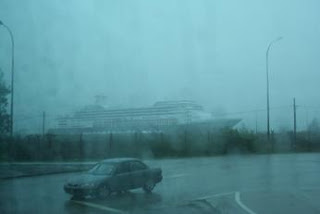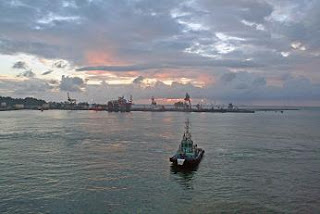














Our arrival at Kemaman in Malaysia was greeted with gas burnoff and the smell of oil
As Rotterdam docked the sun rose and rain clouds gathered
Squeek and Moss at the river port of Kuantan
The boat that would take us up the river into the Malaysian countryside
Colourful fishing boats lined the river in some places . . .
. . . and we saw one boat auctioning its catch of the day
We entered the mangrove jungle lands along the side of the river . . .
. . . and at one place we got out and walked along a trail into the heart of the swamp . . .
. . . and it was raining pretty hard on us by this time.
We saw eagles perched, looking for food . . .
. . . and catching it . . .
. . . and monkeys looking at us
We stopped at the Grand Mosque in Kuantan . . .
. . . and Squeekie took this picture of the interior, looking toward the prayer hall.
By the time we returned to Rotterdam docked at Kemaman it was raining hard, but the rain was warm—we are in the tropics!
Fifty-fourth Day (Saturday, March 14, 2009)-- Today was an “at sea” day, and Squeekie and I spent much of it up in the Crow’s Nest on Deck Nine, working on journals and pictures. At dinner this evening Iris and Don joined us for dinner at our table, and we had a wonderful time chatting with them. They are very nice people and I am glad we have gotten to know them.
Fifty-fifth Day (Sunday, March 15, 2009)-- Rotterdam was just sailing in to the oil port of Kemaman in Malaysia when Squeekie and I woke up this morning. We knew it was an oil port (a place where oil is loaded or unloaded and refined) because of the smell in the air—the rotten egg smell of hydrogen sulfide told us that Southeast Asian oil was being handled (like California oil from years past, it is high in sulfur). When we went out on our verandah we saw a land touched—perhaps I should say polluted—by oil; in the near distance was an oil refinery, replete with tanks and towers, and a flaming gas burn-off tower glowing away to greet us as we arrived. Welcome to Malaysia, a land recently touched by oil. . . . The port of Kemaman is very modern in every way because oil is here. In fact, Captain Olav had told us earlier that Rotterdam would thread between oil platforms on the approach to this port, but we saw none of that because we were asleep. After picking up the pilot Rotterdam proceeded through a channel dredged to a depth of 59 feet (18 meters) in order to accommodate the large container and liquefied gas tankers that now come to Kemaman. This port, which is the major petroleum and chemical facility on the Malay Peninsula’s east coast, has specialized industries able to handle oil, gas, and petrochemicals. We docked on the West Wharf which clearly was not designed to regularly handle cruise ships.
A moment of history-- Kemaman, which is on the East Coast of the Malay Peninsula in the Malaysian state of Terenngganu, faces the South China Sea. It was known to have existed as early as the second century BCE, and was shown on a map of the Malay Peninsula drawn by the Greco-Roman geographer Claudius Ptolemy around 120 AD. Kemaman (also known as Chukai, from the Malay word for taxes) and the nearby town of Kuantan were known to act as defense (and tax) centres protecting the rivers which came out into the South China Sea here; however, the region’s written history is scarce (writing existed among some of the civilizations which lived here, but unless carved in stone written documents tended to disintegrate in the tropical climate). From the middle of the eighteenth century AD, however, a history does exist. We know that the aboriginal tribes in the region were pushed aside by Chinese, Indian, and British migrants who built thriving industries in the production of salted fish and iron; later, as Malaya became a British colony, industries developed in the production of tin, rubber, and coconut fibres. (Malaysian tin became VERY important in the 1840s as the technology to can food developed just at the moment when Cornwall’s tin mines petered out.) Indeed, from the 1890s until World War Two, the British colony of Malaya was one of the world’s largest exporters of latex rubber. Although Malaya was seized by the Japanese in 1942, the British fought to get back their major source of rubber. (The Rotterdam passed over the final resting place of the two British battleships sent to stop the Japanese landings; the Prince of Wales and the Repulse were sunk by air attack on December 10, 1941, a tragedy which also pretty much marked the end of battleship construction.) After 1945 the British fought a guerilla war to prevent Communist insurgents from claiming the country, and when that was won they gave the Malay states their independence. Oil was discovered just off the coast in the 1980s, and this has turned the area into a major port as described above. Malaysia’s national oil company, Petronas (whose corporate headquarters in the national capital of Kuala Lumpur was briefly the world’s tallest building), operates one of the world’s largest liquefied petroleum gas export terminals in Kemaman. Malaysia is today a constitutional monarchy on the British pattern. Its thirteen states are located on the Malay Peninsula, which hangs down from Thailand, and on the northern portion of the big island of Borneo. Singapore, a small island at the southern tip of the Malay Peninsula, started out as one of the states, but broke away to form its own nation in 1965 (see my later blog on Singapore, coming soon). Malaysia is predominantly Islamic, but its constitution allows freedom of worship.
OK, back to our adventure-- Rotterdam’s docking in the deepwater Kemaman port meant that we were some 20 kilometers away from the major town in the area, Kuantan. This meant that we had to bus some distance for our tours. Several women in traditional Malaysian dress were gathered at the end of the gangway greeting passengers as we disembarked from the ship. They gave each woman a paper rose with some candy tied to the stem, and this made us feel very welcomed to this country.
Our excursion today was a river cruise along the Kuantan River, about an hour and a half drive from the wharf area. Our guide Billy was a Chinese man from Kuala Lumpur who spoke English well and kept up a running dialogue on local history and culture. The road our bus took to Kuantan was just like any recently-constructed highway in the United States, very modern and very fast by Asian standards, although maybe that was just because it still was early on a Sunday morning. Little villages, each with their own mosque, passed by our windows, and new western-style construction could be seen everywhere.
Unfortunately, a major rainstorm seems to have found us today, and it was raining very heavily as we boarded our river boat—thankfully Squeekie had reminded me to bring a poncho, so we both (and our cameras) were relatively dry all day. Our ride on the river lasted about an hour. As we putt-putted up the river we saw mangrove trees all along both banks, stretching their roots down into the river water and creating a dense jungle that was filled with wildlife. We saw some eagles up in the trees and a large stork boldly standing watch on the branch of a dead tree. Some monkeys, also in a tree, added to the wildlife show. (See the appended pictures.) Little fishing villages also could be seen along the banks, each one of them lined with the gaudily-painted wooden fishing boats which are a cultural icon in Malaysia. At one of these villages we stopped briefly to watch as one boat auctioned off its catch of the day.
Our guide explained that mangrove trees can live in both salt water and fresh water, removing the salt from the water before being able to use it in their own sap systems; the surplus salt accumulates on the leaves of the tree and eventually is either blown away or washed off in the rain. At one point we disembarked from our riverboat for a walk on a raised wooden walkway that allowed us to see up close the mangrove forest and its animals. Despite the rain (from which we were partially sheltered by the mangrove tree leaves) this was a pleasant walk. This walkway enabled us to see many different jungle plants and trees, and some animals as well—I was particularly interested in tiny crabs which had built a high mud pile as their home.
After the river ride was ended our bus toured through the city of Kuantan (which is the capital of Pahang state). We stopped to photograph the blue and white domes of the local State Mosque, Masjid Negeri, and Squeekie was even allowed to go inside the door and photograph some of the interior—a first for this trip! The town was interesting and very westernized in many ways, but the rain became heavier as we headed back to the Rotterdam.
Squeekie wanted to visit the small market area that had been set up on the dock beside our ship, and I walked with her even though my feet were hurting. We did not purchase anything however. We spent the rest of the day aboard the Rotterdam with our new Canadian friends Iris and Don. I would like to come back to Malaysia, which seemed to be more westernized and less impoverished than did Indonesia. The Malaysians we encountered seemed to be proud of their country and were very friendly to us. Rotterdam left the port at five o’clock for the relatively short journey south to our next port, the famous Singapore.
No comments:
Post a Comment